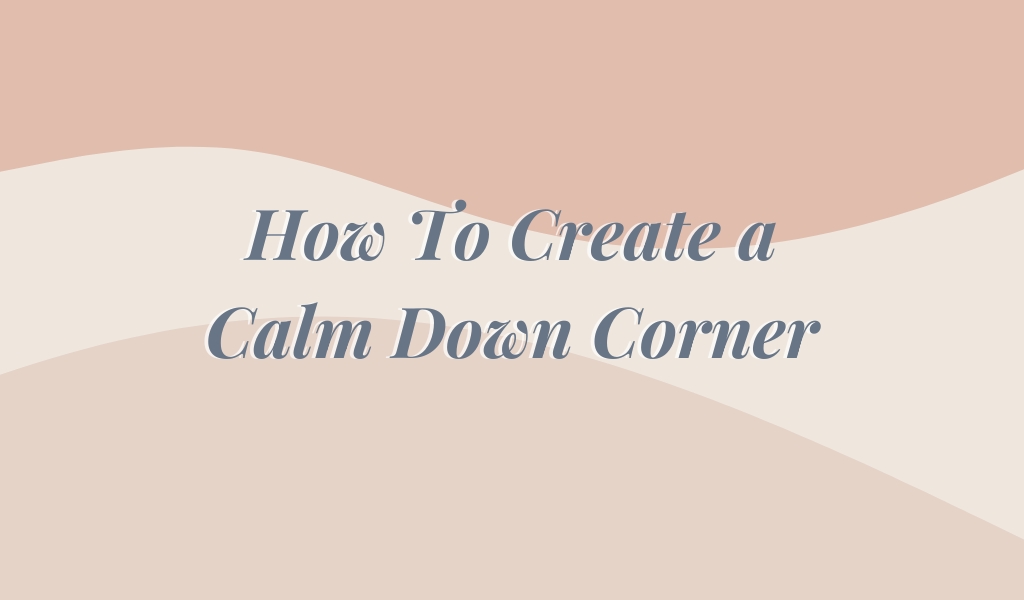
Why a Calm Down Corner is More Effective Than Time-Outs
Your child is mid-meltdown. Their emotions are spiraling, tears are flowing, and frustration is turning into full-on overwhelm.
What’s your first instinct?
For many parents, the automatic response is a time-out—a break meant to stop the behavior and reset the moment.
But here’s the truth: Time-outs don’t teach kids how to regulate their emotions.
They isolate instead of guide. They may stop the outburst in the short term, but they don’t help kids learn what to do with their big emotions.
💡 What works better? A Calm Down Corner—a dedicated emotional regulation space designed to help kids self-soothe, process emotions, and regain control.
But before you start throwing pillows in a corner and calling it done, let’s talk about the right way to set up a Calm Down Corner (and the common mistakes that make them ineffective).
3 Common Mistakes Parents Make When Creating a Calm Down Corner
Setting up a Calm Down Corner seems simple, but many parents unknowingly make mistakes that prevent it from working.
❌ Mistake #1: Making It Feel Like a Punishment
A Calm Down Corner is not a “go sit there until you calm down” space. If a child feels like they’re being sent away as punishment, they’ll resist using it when they need it most.
✔ Instead, invite them to use it as a tool for feeling better—not as a place they’re forced to go.
❌ Mistake #2: Not Having the Right Tools in Place
A corner with a pillow isn’t enough. Kids need physical tools to help regulate their emotions.
✔ Sensory calm down tools, like breathing charts, fidget toys, and grounding visuals, make a huge difference in how effective the space is.
❌ Mistake #3: Expecting It to Work Instantly
The first time you introduce a Calm Down Corner, your child might ignore it. That’s normal.
✔ Emotional regulation is a learned skill—the more they practice, the more natural it becomes.
How to Make Your Calm Down Corner Actually Work
Now that you know what not to do, let’s talk about what makes a Calm Down Corner truly effective.
✅ Step 1: Choose a Quiet, Safe Spot
Find a space that feels calm and inviting—away from high-traffic areas. A small corner in their bedroom, playroom, or a cozy reading nook works well.
✅ Step 2: Include Multi-Sensory Calm Down Tools
The key to success? Providing the right tools for self-regulation. Your Calm Down Corner should include:
✔ Visual calming charts (breathing exercises, feelings charts)
✔ Tactile sensory tools (stress balls, fidget toys, weighted lap pads)
✔ Comfort items (soft pillows, cozy blankets, stuffed animals)
✔ Journals or coloring books for self-expression
👉 My Calm Down Corner Kits includes all the essentials, so you don’t have to piece it together yourself and you can get it with a LIMITED-TIME Special Discount!
✅ Step 3: Teach Your Child How to Use It
A Calm Down Corner only works if your child understands when and how to use it.
✔ Model it yourself—let them see you using the space for deep breaths and relaxation.
✔ Use it together the first few times so they feel safe and supported.
✔ Reinforce it positively: “This is a space to help you feel better, not a place for punishment.”
✅ Step 4: Make It a Daily Practice, Not Just for Meltdowns
Help your child build emotional regulation skills by encouraging them to use the space before big emotions escalate.
💡 Tip: Start with “Calm Down Time” every day for 5 minutes to help them associate the space with peace, not just distress.
Make Emotional Regulation Easy for Your Child
You don’t have to figure this all out alone. My Calm Down Corner Kits takes the guesswork out of setting up a proven emotional regulation space—so you can focus on connection, not frustration.
✔ Includes ready-to-use charts, tools, and sensory supports
✔ Helps kids self-regulate without needing constant intervention
✔ Designed to work for toddlers, preschoolers, and elementary-aged kids
🎁 Ready to create a Calm Down Corner that actually works?
Already Have the Calm Down Corner Kit?
Want direct step-by-step guidance on how to introduce, use, and reinforce the Calm Down Corner tools?
📌 The Essentials Toolkit walks you through exactly how to implement the visuals, charts, and tools so your child actually uses them.
✅ Get The Essentials Toolkit Here
Next Steps: Helping Your Child Build Emotional Regulation Skills
A Calm Down Corner is just one piece of the puzzle. If you want long-term transformation, it’s important to understand the bigger picture of emotional regulation.
Learn the full framework inside:
👉 How to Teach Kids Emotional Regulation Using The CALM Method
👉 Want more insights on raising emotionally connected kids? Join my weekly parenting newsletter for deeper guidance and real-life strategies.
